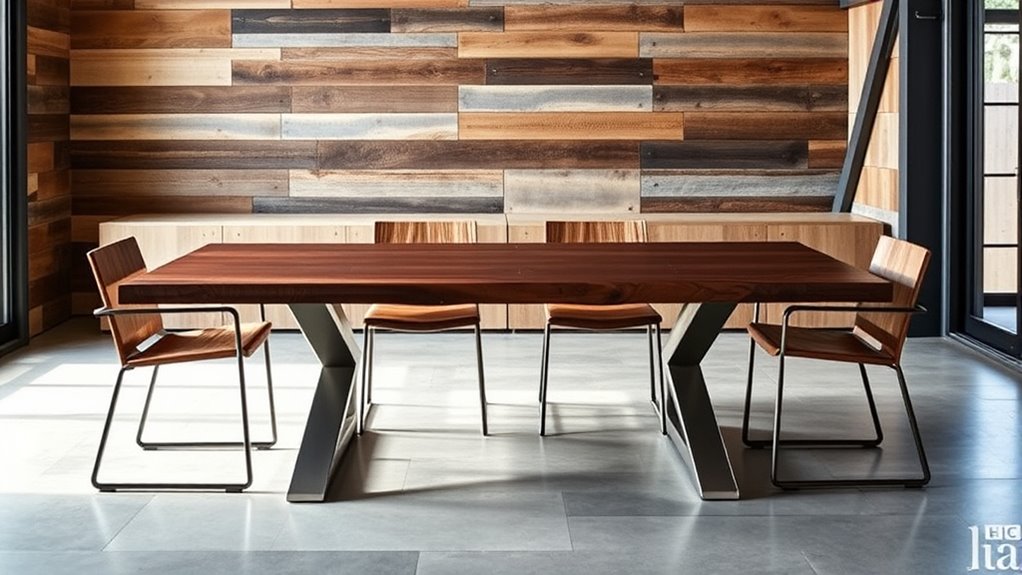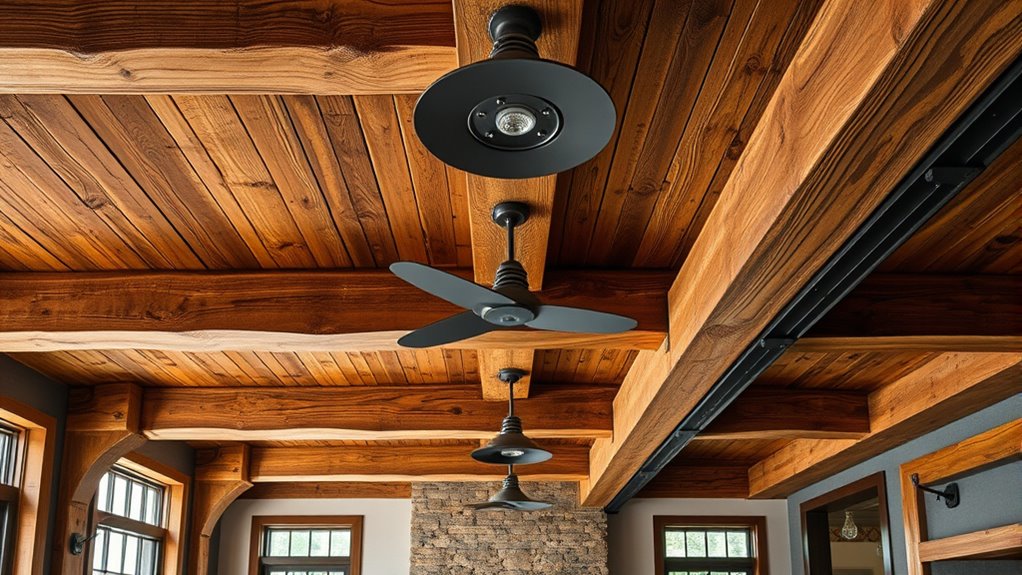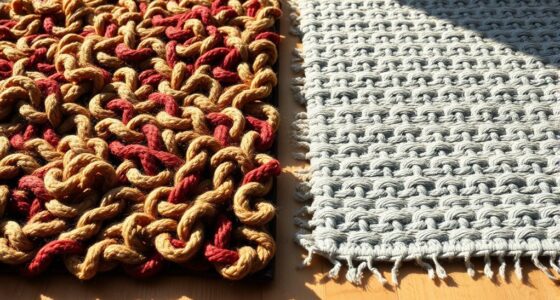Reclaimed wood and recycled steel are revolutionizing luxury interiors by blending sustainability with striking design. You can incorporate salvaged wood with rich history and unique imperfections for warmth and character, while recycled steel adds durability and modern accents. These materials promote responsible resource management, reduce waste, and support a circular economy. They also help create spaces that balance industrial ruggedness with refined elegance. Continue exploring how these eco-friendly choices are shaping cutting-edge interior styles and client appeal.
Key Takeaways
- Reclaimed wood adds historic character and warmth, enhancing luxury interiors with sustainable, visually rich textures.
- Recycled steel offers durable, versatile structural and decorative elements supporting eco-friendly design.
- These materials enable innovative, customizable designs that blend industrial appeal with modern elegance.
- Utilizing reclaimed and recycled materials demonstrates environmental responsibility, boosting client appeal and project value.
- Their unique aesthetic qualities challenge the notion that sustainable materials compromise luxury and sophistication.

Have you ever wondered how sustainable building materials can transform your projects? When you choose reclaimed wood and recycled steel, you’re not just making an eco-friendly decision—you’re elevating your design with materials that tell a story. These choices embody sustainable sourcing, ensuring that you’re using resources responsibly and reducing waste. Reclaimed wood, often salvaged from old barns, factories, or demolished structures, carries a rich history and a unique character that new materials simply can’t replicate. Its imperfections, grain patterns, and patinas add depth and authenticity to your interiors, creating a warm, inviting atmosphere that feels both timeless and modern. Recycled steel, on the other hand, offers durability and strength while minimizing environmental impact. By repurposing steel from existing sources, you’re supporting a circular economy that reduces the need for virgin mining and manufacturing. This approach aligns perfectly with contemporary values of sustainability and resource conservation.
Using these materials also allows you to embrace industrial aesthetics, a trend that celebrates raw, unfinished, and utilitarian beauty. Reclaimed wood’s weathered surfaces, knots, and irregularities contribute to an industrial-inspired palette that feels organic yet edgy. Paired with recycled steel’s sleek, minimalist appeal, you can craft interiors that are both striking and sustainable. This combination creates a harmonious balance between rugged textures and polished finishes, giving your space a distinctive character. Plus, these materials are incredibly versatile; reclaimed wood can be used for statement walls, furniture, or cabinetry, while recycled steel can serve as structural elements, accents, or decorative features. Their adaptability means you can design interiors that are both functional and visually compelling.
Another benefit is that utilizing reclaimed wood and recycled steel often shortens project timelines. Since these materials are already processed and prepared, they can be sourced quickly, reducing delays associated with new material procurement. Furthermore, working with sustainable sourcing practices shows your commitment to environmental responsibility, which clients increasingly prioritize. It demonstrates that your projects are thoughtfully designed with a focus on reducing ecological footprints without sacrificing style or quality. By integrating reclaimed wood and recycled steel into your interior designs, you’re championing innovation and sustainability—creating spaces that are not only luxurious but also conscientious. These materials challenge the notion that eco-friendly design must compromise on aesthetics, proving instead that beauty and sustainability can go hand-in-hand. Ultimately, choosing reclaimed wood and recycled steel allows you to craft interiors that are not only visually enthralling but also aligned with a forward-thinking approach to building and design.
Frequently Asked Questions
How Do Reclaimed Wood and Recycled Steel Impact Indoor Air Quality?
Reclaimed wood and recycled steel generally improve indoor air quality by reducing VOC emissions compared to new materials. Since these recycled materials are often pre-treated or naturally dried, they emit fewer pollutants, helping to lower indoor air pollution. You’ll notice fresher air and fewer allergies, especially if you choose sustainably sourced options. Overall, these eco-friendly materials contribute to a healthier, safer indoor environment for you and your family.
Are There Any Maintenance Requirements for Reclaimed Wood Surfaces?
You should perform regular cleaning procedures like dusting and gentle wiping to maintain reclaimed wood surfaces. To preserve their beauty, use preservation techniques such as applying natural oils or sealants periodically. Avoid harsh chemicals that can damage the wood, and keep moisture levels stable to prevent warping or cracking. With proper maintenance, your reclaimed wood surfaces will stay stunning and durable for years to come.
What Are the Cost Differences Compared to Traditional Materials?
You’ll find that reclaimed wood and recycled steel often cost 10-30% more than traditional materials, mainly due to their sustainable sourcing and unique character. However, their material affordability can vary based on project size and customization. While initial costs might be higher, many designers see them as a worthwhile investment for eco-friendly luxury interiors, especially considering their durability and distinctive aesthetic.
How Do These Materials Perform in Extreme Weather Conditions?
You’ll find that reclaimed wood and recycled steel perform well in extreme weather conditions thanks to their weather resilience and material durability. Reclaimed wood is treated to withstand moisture and temperature changes, while recycled steel resists rust and corrosion, even in harsh climates. These materials maintain their strength and appearance over time, ensuring your luxury interiors stay protected and beautiful, regardless of weather challenges.
Can Reclaimed Wood and Recycled Steel Be Integrated Into Existing Designs?
You can seamlessly integrate reclaimed wood and recycled steel into your existing designs, symbolizing sustainability and timeless craftsmanship. Focus on design compatibility to guarantee a harmonious look, and be mindful of installation challenges like proper preparation and skilled labor. With careful planning, these materials add character and eco-conscious elegance, blending old-world charm with modern innovation to elevate your space. Embrace the transformation, making sustainability a beautiful part of your interior story.
Conclusion
Embracing reclaimed wood and recycled steel transforms luxury interiors into stories of sustainability and style. These materials breathe new life into spaces, turning them into living, breathing works of art. Like a phoenix rising from ashes, they showcase how eco-friendly choices can lead to breathtaking design. By choosing these innovative materials, you’re not just decorating—you’re making a bold statement for the planet and creating a timeless space that echoes with purpose and beauty.









